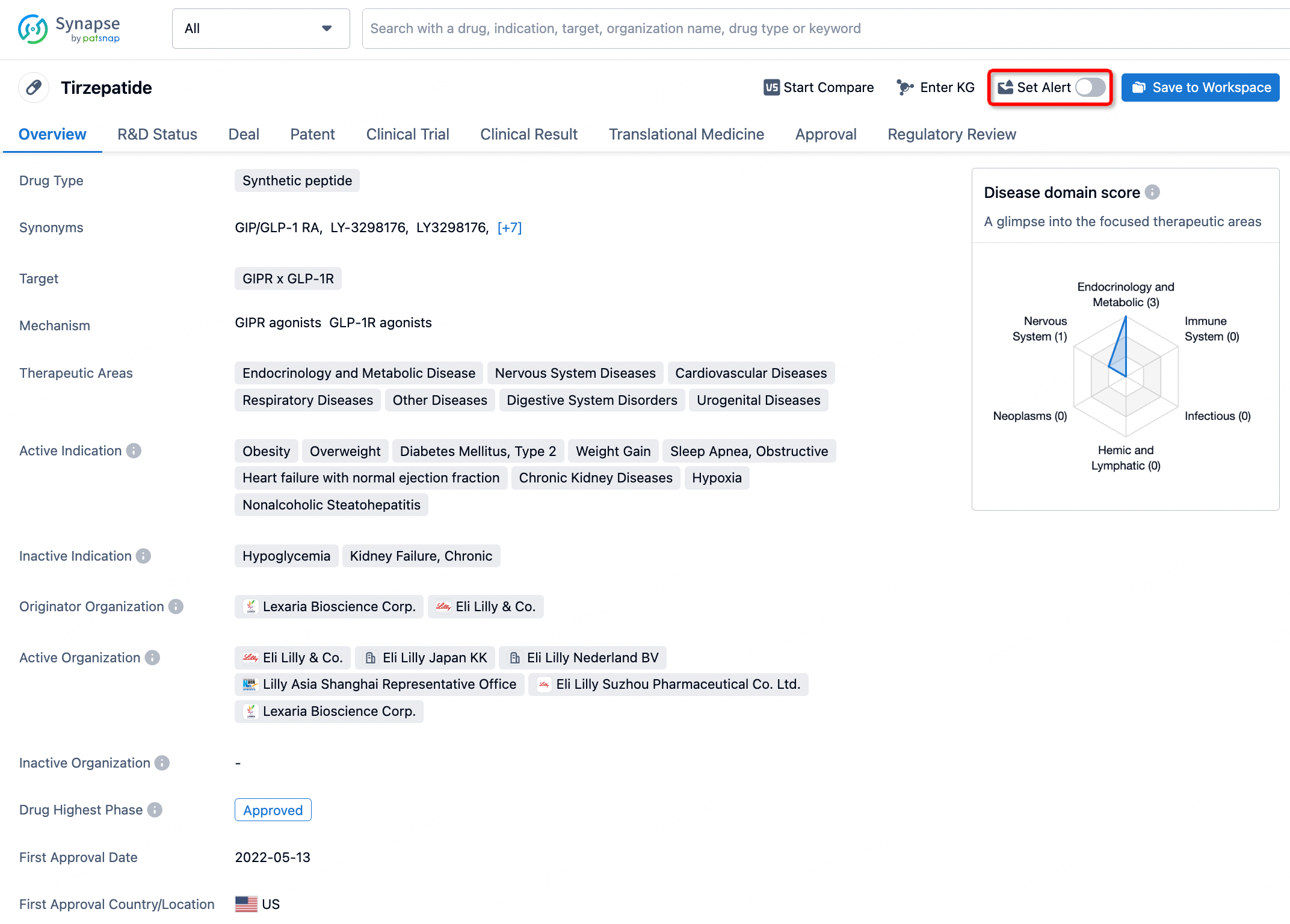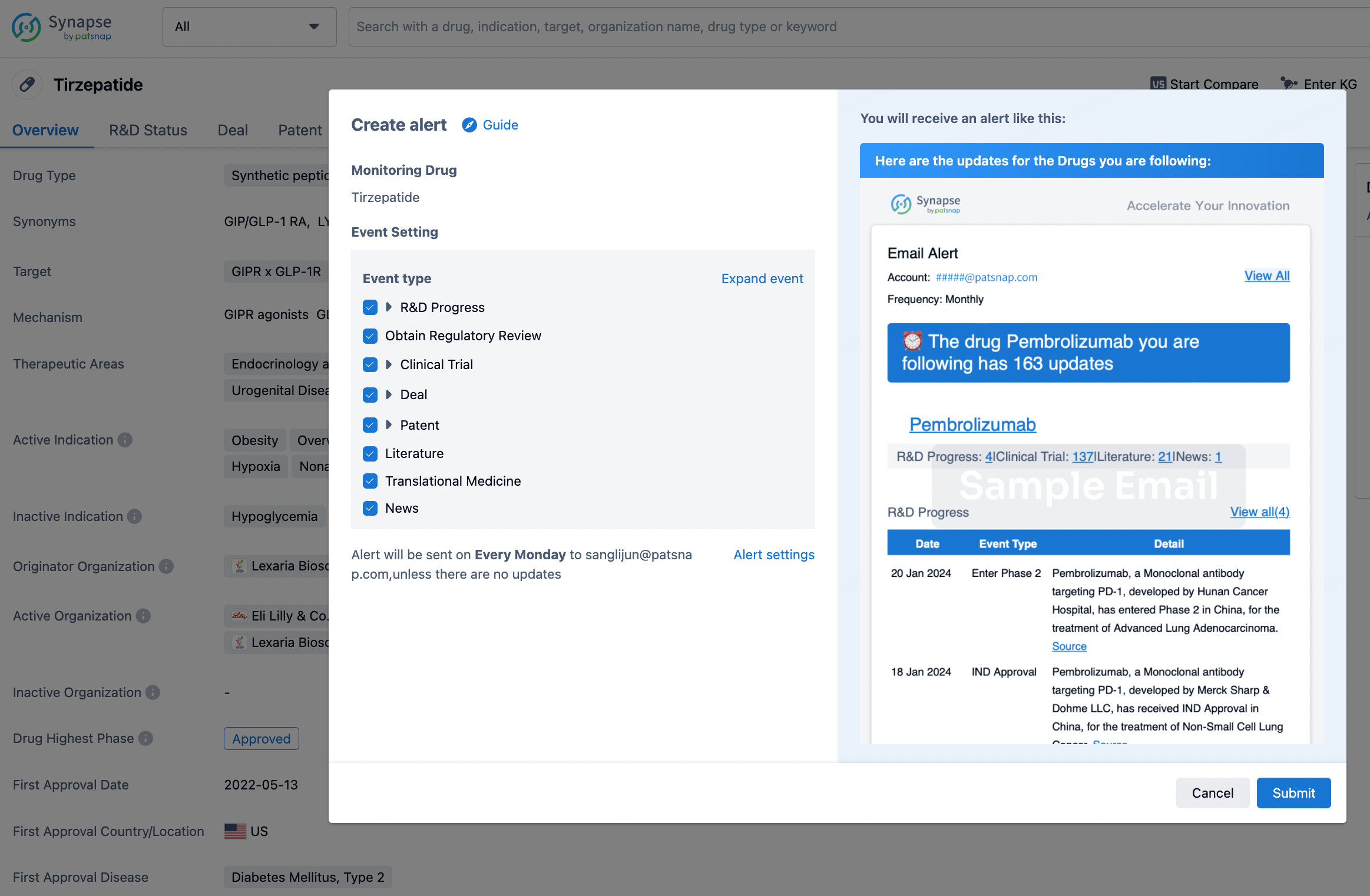Request Demo
What is Clodronate Disodium used for?
15 June 2024
Clodronate Disodium is a fascinating compound that has garnered attention in the medical community for its diverse range of applications. Known commercially under trade names such as Bonefos, Ostac, and Loron, this bisphosphonate serves primarily as an anti-resorptive agent. It targets bone metabolism and is particularly effective in treating diseases characterized by excessive bone resorption. Institutions around the globe, including prominent research facilities and universities, have delved into understanding its potential. The drug is categorized under bisphosphonates and finds its primary indications in managing conditions like osteoporosis, Paget's disease, hypercalcemia of malignancy, and bone metastases. While initial research has demonstrated promising results, ongoing studies aim to further elucidate its efficacy and safety profile.
Clodronate Disodium Mechanism of Action
The mechanism of action of Clodronate Disodium is intriguing and centers around its ability to affect bone metabolism. Bisphosphonates, in general, have a high affinity for hydroxyapatite, a major component of bone mineral. When Clodronate Disodium is administered, it binds strongly to the bone surface. Once attached, it is ingested by osteoclasts—the cells responsible for bone resorption. Within these cells, Clodronate Disodium inhibits the mevalonate pathway, crucial for the synthesis of certain lipids necessary for osteoclast function. This inhibition ultimately leads to the reduction of osteoclast activity, slowing down the bone resorption process. Additionally, Clodronate Disodium has been noted to induce apoptosis in osteoclasts, further reducing their numbers and activity. The net effect is a decrease in bone turnover, making it a potent therapeutic agent for conditions involving excessive bone degradation.
How to Use Clodronate Disodium
Administering Clodronate Disodium requires careful consideration of the condition being treated and the specific guidelines provided by healthcare providers. The drug is available in several forms, including oral tablets and intravenous infusions. For oral administration, it is typically recommended to take the tablets on an empty stomach, either two hours before or after meals, to enhance absorption. Patients are often advised to swallow the tablets whole with a full glass of water and remain upright for at least 30 minutes to prevent potential esophageal irritation.
Intravenous administration of Clodronate Disodium is generally reserved for more severe conditions, such as acute hypercalcemia of malignancy or significant bone metastases. This method allows for direct delivery into the bloodstream, ensuring rapid onset of action. The dose and duration of intravenous therapy can vary based on the severity of the condition and the patient's overall health.
The onset time of Clodronate Disodium can vary. For oral administration, therapeutic effects might take several weeks to become evident. In contrast, intravenous administration can produce noticeable effects within a few days, especially in acute settings. It is crucial for patients to adhere to their prescribed regimen and consult their healthcare provider for any adjustments or concerns.
What is Clodronate Disodium Side Effects
Like all medications, Clodronate Disodium has a range of potential side effects, and understanding them is crucial for both patients and healthcare providers. Common side effects include gastrointestinal disturbances such as nausea, vomiting, diarrhea, and abdominal pain. These effects are often transient and can be mitigated by adhering to administration guidelines, such as taking the drug with plenty of water and remaining upright.
More serious side effects, although less common, include renal toxicity, especially with high doses or prolonged use. Patients with pre-existing kidney conditions should use Clodronate Disodium with caution and under strict medical supervision. Another notable side effect is osteonecrosis of the jaw (ONJ), particularly in patients receiving intravenous bisphosphonates for cancer-related conditions. This condition involves the deterioration of jawbone tissue and can be severe, necessitating prompt medical intervention.
Hypocalcemia, or low blood calcium levels, is another potential side effect, as Clodronate Disodium can interfere with calcium metabolism. Symptoms of hypocalcemia include muscle cramps, tingling sensations, and, in severe cases, cardiac abnormalities. Patients are often advised to maintain adequate calcium and vitamin D intake during therapy to mitigate this risk.
Contraindications for Clodronate Disodium use include hypersensitivity to bisphosphonates, severe renal impairment, and certain gastrointestinal conditions. Pregnant and breastfeeding women should avoid the drug unless absolutely necessary, as its safety in these populations has not been fully established.
What Other Drugs Will Affect Clodronate Disodium
Clodronate Disodium can interact with several other medications, potentially altering its efficacy and safety profile. Calcium supplements and antacids, for instance, can interfere with the absorption of oral Clodronate Disodium. It is generally recommended to take these supplements at least two hours apart from the bisphosphonate to avoid interaction.
Nonsteroidal anti-inflammatory drugs (NSAIDs) can increase the risk of gastrointestinal side effects when taken with Clodronate Disodium. Patients should inform their healthcare provider about any NSAID use so that appropriate measures can be taken to minimize risks.
Aminoglycoside antibiotics, known for their nephrotoxic potential, can exacerbate the renal toxicity of Clodronate Disodium. Concurrent use should be approached with caution and under close medical supervision.
Additionally, drugs that affect renal function, such as diuretics, can influence the excretion and overall pharmacokinetics of Clodronate Disodium. Healthcare providers may need to adjust dosages or monitor renal function closely when these drugs are used concurrently.
In conclusion, Clodronate Disodium is a valuable therapeutic agent in the management of various bone-related conditions. Its mechanism of action, focusing on the inhibition of osteoclast activity, makes it particularly effective in reducing bone resorption. However, like all medications, it comes with a range of potential side effects and interactions that necessitate careful consideration and monitoring. By understanding these aspects, both patients and healthcare providers can maximize the benefits of Clodronate Disodium while minimizing its risks.
Clodronate Disodium Mechanism of Action
The mechanism of action of Clodronate Disodium is intriguing and centers around its ability to affect bone metabolism. Bisphosphonates, in general, have a high affinity for hydroxyapatite, a major component of bone mineral. When Clodronate Disodium is administered, it binds strongly to the bone surface. Once attached, it is ingested by osteoclasts—the cells responsible for bone resorption. Within these cells, Clodronate Disodium inhibits the mevalonate pathway, crucial for the synthesis of certain lipids necessary for osteoclast function. This inhibition ultimately leads to the reduction of osteoclast activity, slowing down the bone resorption process. Additionally, Clodronate Disodium has been noted to induce apoptosis in osteoclasts, further reducing their numbers and activity. The net effect is a decrease in bone turnover, making it a potent therapeutic agent for conditions involving excessive bone degradation.
How to Use Clodronate Disodium
Administering Clodronate Disodium requires careful consideration of the condition being treated and the specific guidelines provided by healthcare providers. The drug is available in several forms, including oral tablets and intravenous infusions. For oral administration, it is typically recommended to take the tablets on an empty stomach, either two hours before or after meals, to enhance absorption. Patients are often advised to swallow the tablets whole with a full glass of water and remain upright for at least 30 minutes to prevent potential esophageal irritation.
Intravenous administration of Clodronate Disodium is generally reserved for more severe conditions, such as acute hypercalcemia of malignancy or significant bone metastases. This method allows for direct delivery into the bloodstream, ensuring rapid onset of action. The dose and duration of intravenous therapy can vary based on the severity of the condition and the patient's overall health.
The onset time of Clodronate Disodium can vary. For oral administration, therapeutic effects might take several weeks to become evident. In contrast, intravenous administration can produce noticeable effects within a few days, especially in acute settings. It is crucial for patients to adhere to their prescribed regimen and consult their healthcare provider for any adjustments or concerns.
What is Clodronate Disodium Side Effects
Like all medications, Clodronate Disodium has a range of potential side effects, and understanding them is crucial for both patients and healthcare providers. Common side effects include gastrointestinal disturbances such as nausea, vomiting, diarrhea, and abdominal pain. These effects are often transient and can be mitigated by adhering to administration guidelines, such as taking the drug with plenty of water and remaining upright.
More serious side effects, although less common, include renal toxicity, especially with high doses or prolonged use. Patients with pre-existing kidney conditions should use Clodronate Disodium with caution and under strict medical supervision. Another notable side effect is osteonecrosis of the jaw (ONJ), particularly in patients receiving intravenous bisphosphonates for cancer-related conditions. This condition involves the deterioration of jawbone tissue and can be severe, necessitating prompt medical intervention.
Hypocalcemia, or low blood calcium levels, is another potential side effect, as Clodronate Disodium can interfere with calcium metabolism. Symptoms of hypocalcemia include muscle cramps, tingling sensations, and, in severe cases, cardiac abnormalities. Patients are often advised to maintain adequate calcium and vitamin D intake during therapy to mitigate this risk.
Contraindications for Clodronate Disodium use include hypersensitivity to bisphosphonates, severe renal impairment, and certain gastrointestinal conditions. Pregnant and breastfeeding women should avoid the drug unless absolutely necessary, as its safety in these populations has not been fully established.
What Other Drugs Will Affect Clodronate Disodium
Clodronate Disodium can interact with several other medications, potentially altering its efficacy and safety profile. Calcium supplements and antacids, for instance, can interfere with the absorption of oral Clodronate Disodium. It is generally recommended to take these supplements at least two hours apart from the bisphosphonate to avoid interaction.
Nonsteroidal anti-inflammatory drugs (NSAIDs) can increase the risk of gastrointestinal side effects when taken with Clodronate Disodium. Patients should inform their healthcare provider about any NSAID use so that appropriate measures can be taken to minimize risks.
Aminoglycoside antibiotics, known for their nephrotoxic potential, can exacerbate the renal toxicity of Clodronate Disodium. Concurrent use should be approached with caution and under close medical supervision.
Additionally, drugs that affect renal function, such as diuretics, can influence the excretion and overall pharmacokinetics of Clodronate Disodium. Healthcare providers may need to adjust dosages or monitor renal function closely when these drugs are used concurrently.
In conclusion, Clodronate Disodium is a valuable therapeutic agent in the management of various bone-related conditions. Its mechanism of action, focusing on the inhibition of osteoclast activity, makes it particularly effective in reducing bone resorption. However, like all medications, it comes with a range of potential side effects and interactions that necessitate careful consideration and monitoring. By understanding these aspects, both patients and healthcare providers can maximize the benefits of Clodronate Disodium while minimizing its risks.
How to obtain the latest development progress of all drugs?
In the Synapse database, you can stay updated on the latest research and development advances of all drugs. This service is accessible anytime and anywhere, with updates available daily or weekly. Use the "Set Alert" function to stay informed. Click on the image below to embark on a brand new journey of drug discovery!
AI Agents Built for Biopharma Breakthroughs
Accelerate discovery. Empower decisions. Transform outcomes.
Get started for free today!
Accelerate Strategic R&D decision making with Synapse, PatSnap’s AI-powered Connected Innovation Intelligence Platform Built for Life Sciences Professionals.
Start your data trial now!
Synapse data is also accessible to external entities via APIs or data packages. Empower better decisions with the latest in pharmaceutical intelligence.


